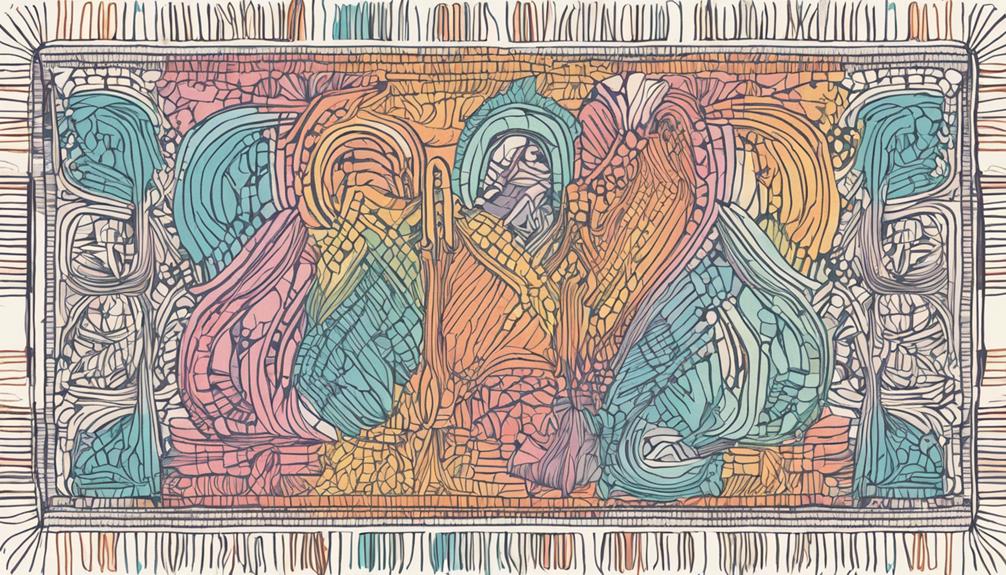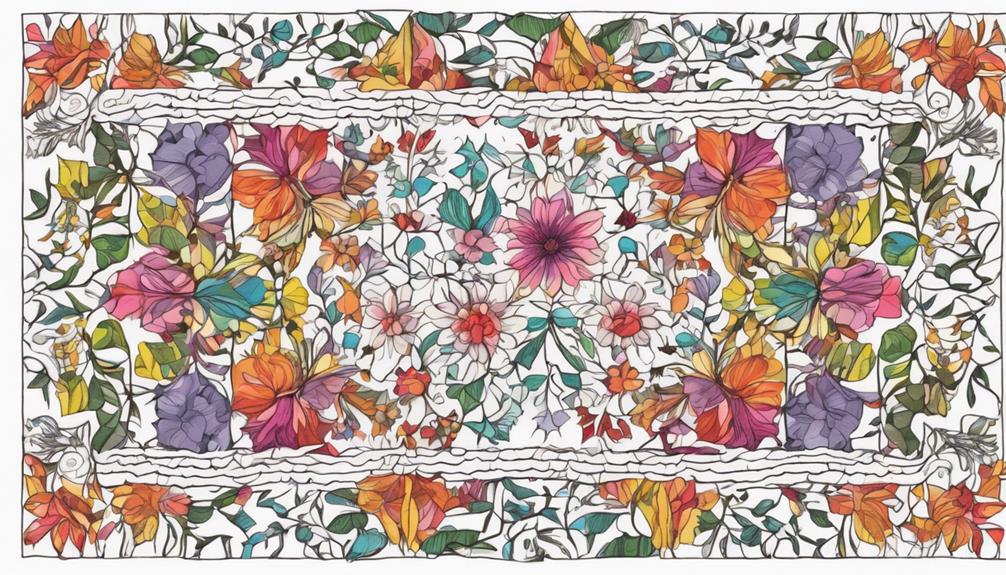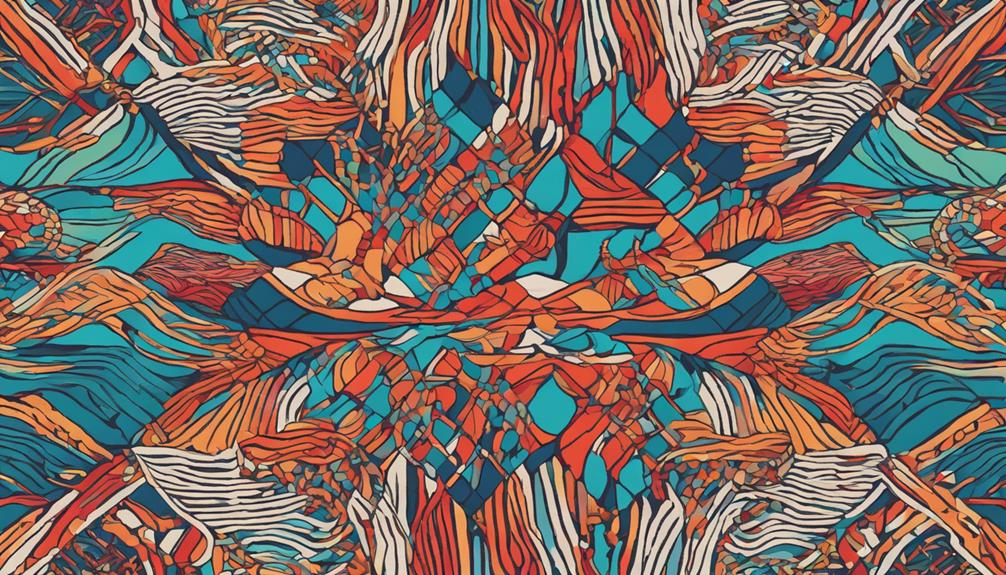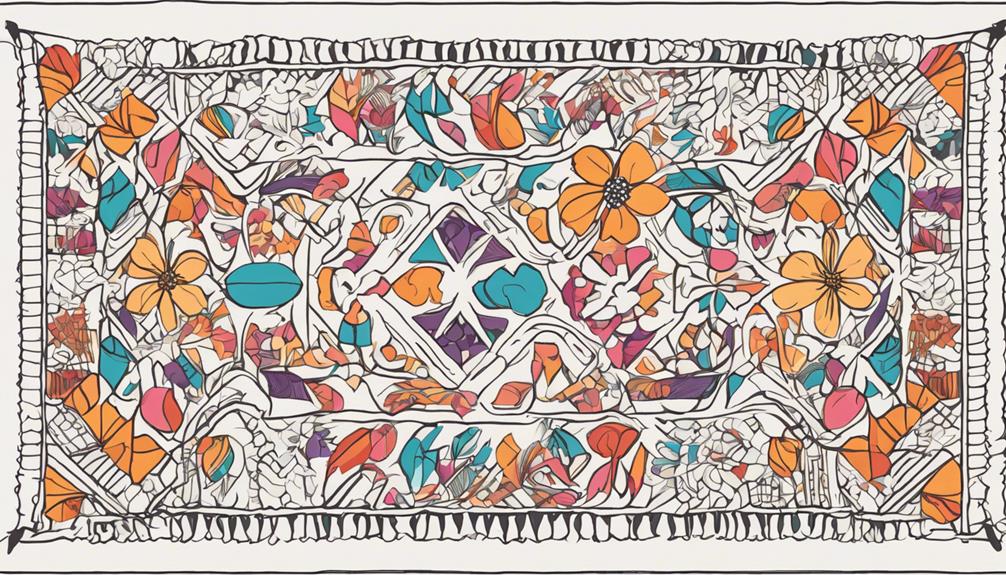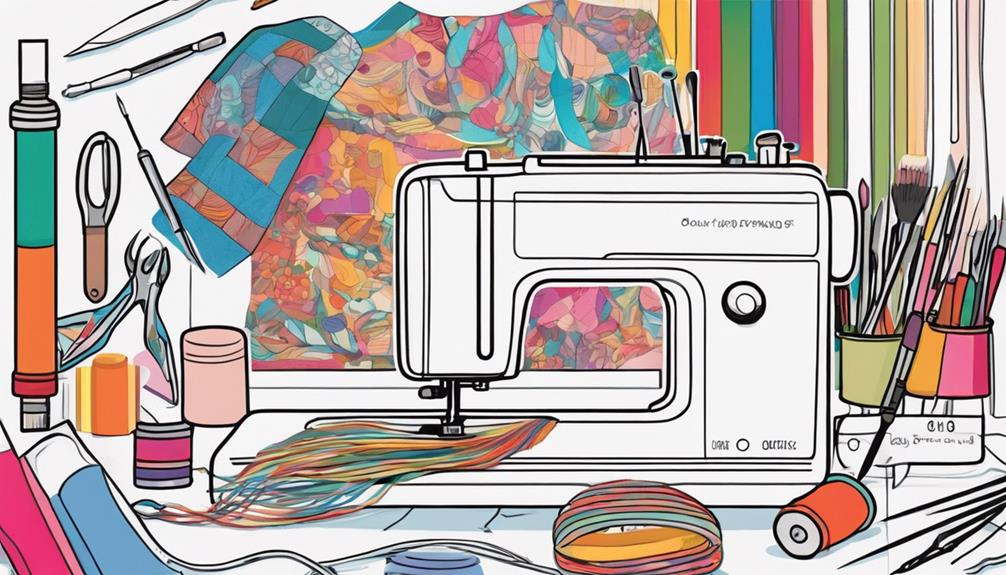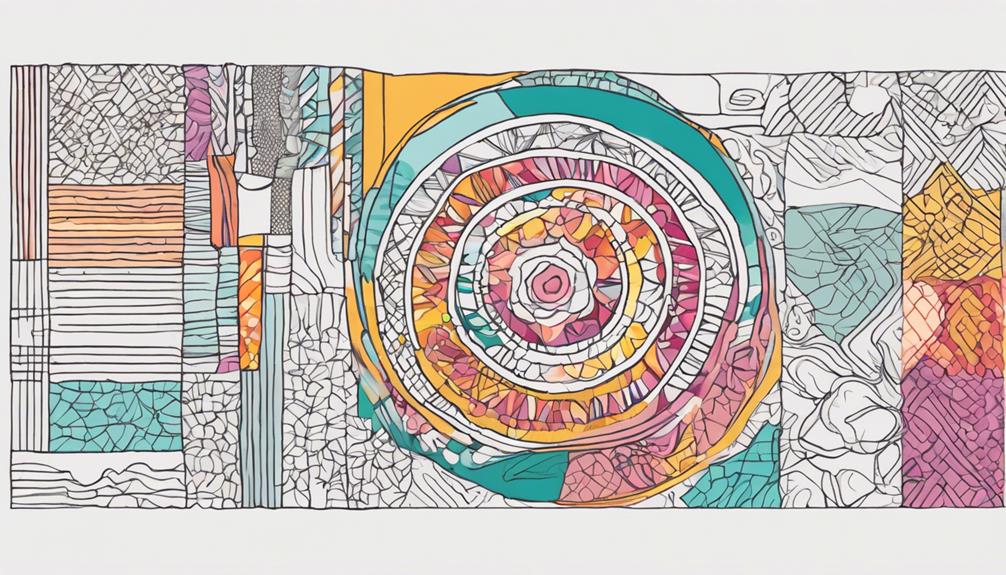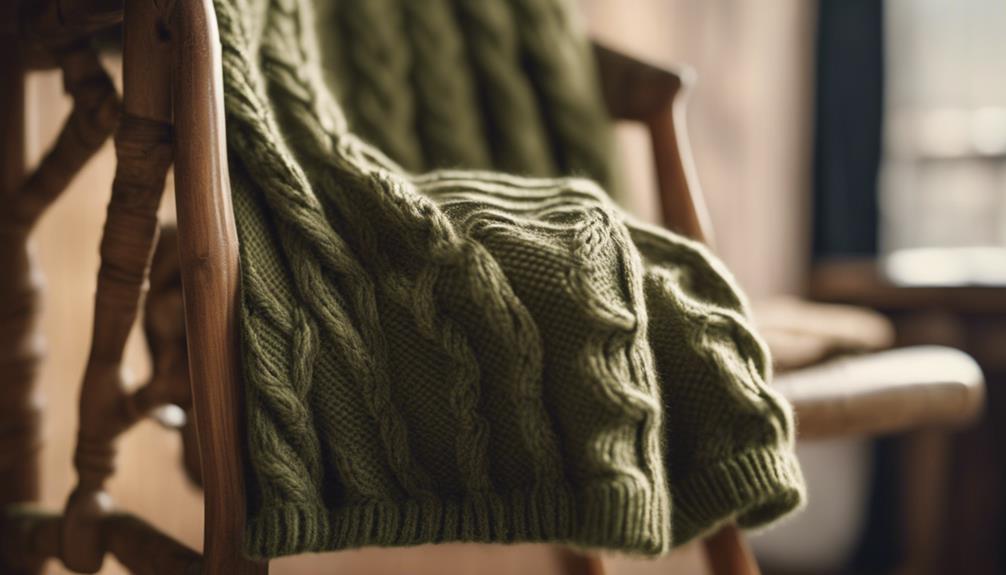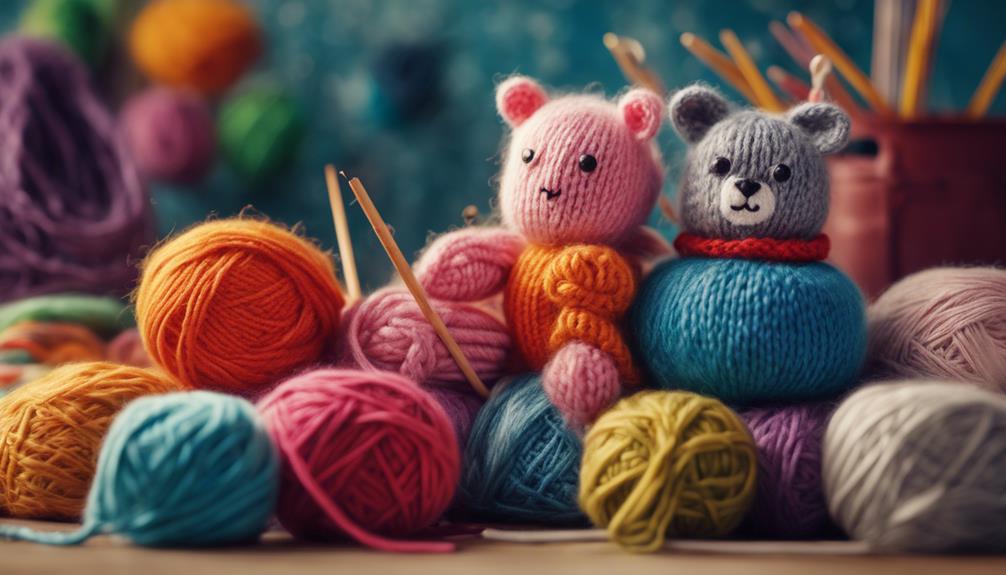Textile art is the art of using fibers and fabrics to tell complex stories and evoke strong emotions. Artists blend traditional and modern techniques to showcase their flexibility in the art world. Different materials like cloth, yarn, fiber, and thread are commonly utilized, each adding its own special textures and details to the artwork. Techniques such as weaving, knitting, crochet, felting, and dyeing offer a variety of ways to create stunning pieces. For those eager to learn more, there is a rich historical context, educational resources, and the enduring importance of textile art waiting to be discovered.
Key Takeaways
- Textile art blends fibers and fabrics creatively.
- It combines traditional crafts with contemporary art.
- Artists convey narratives and emotions through textiles.
- Techniques include weaving, knitting, felting, and dyeing.
- Textile art holds historical significance and relevance.
Textile Art Definition
Textile art is a dynamic and versatile form of artistic expression utilizing fibers and fabrics to create intricate and meaningful works. This form of art encompasses a wide array of techniques such as weaving, embroidery, and quilting, where artists skillfully manipulate fibers and fabrics to convey narratives, emotions, and cultural expressions.
Blurring the lines between traditional crafts and contemporary art, textile art holds both historical significance and a space for innovation. Throughout centuries, textile art has served various purposes including providing warmth, protection, and insulation.
In contemporary times, textile artists continue to push boundaries, exploring new techniques and materials to create unique and innovative pieces. By melding traditional craftsmanship with modern artistic sensibilities, textile artists breathe new life into this age-old practice, showcasing the enduring relevance and adaptability of textile art in the ever-evolving art world.
Materials in Textile Art
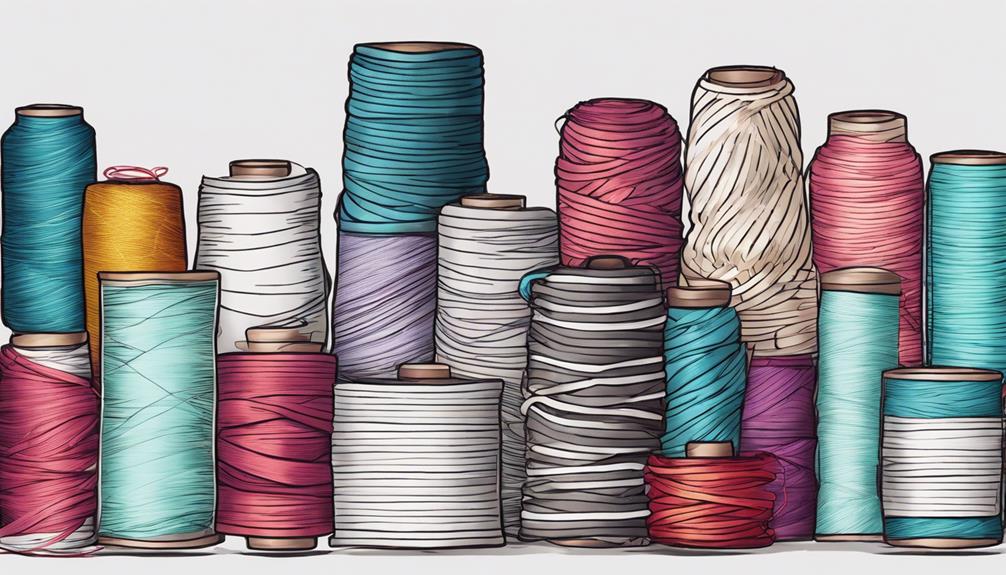
Various materials like cloth, yarn, fiber, thread, and wire fabric are essential components in creating textile artworks.
When working with these materials in textile art, you have a range of options to explore:
- Cloth: Cloth serves as the base material for many textile artworks, providing a foundation for further embellishments.
- Yarn: Yarn offers versatility in texture and color, allowing artists to weave intricate patterns or create bold statements.
- Fiber: Fibers like cotton, wool, silk, and recycled materials such as hemp are commonly used to add depth and character to textile pieces.
- Thread: Thread is utilized in techniques like embroidery to add fine details and intricate designs to the artwork.
Techniques in Textile Creation
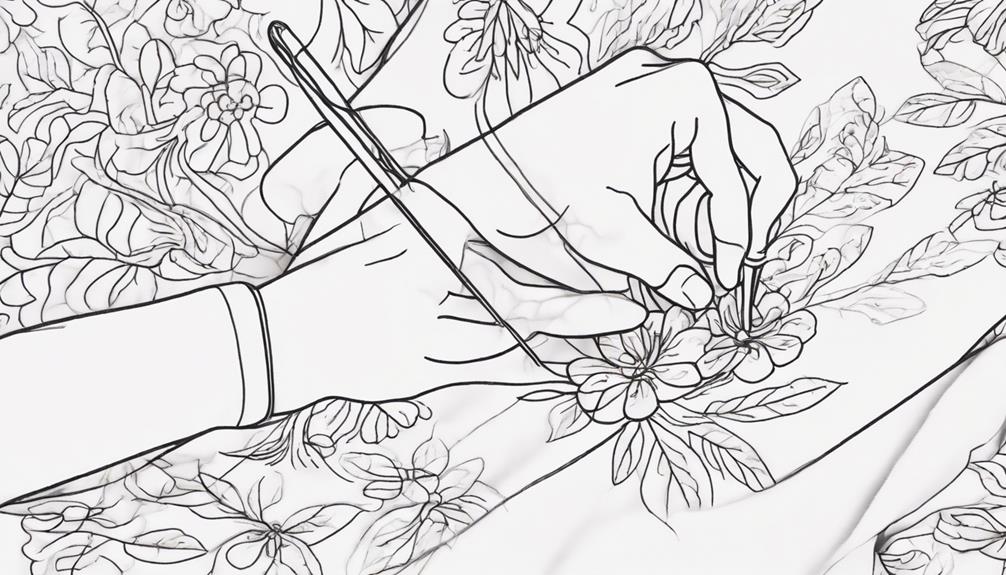
When creating textile art pieces, you can employ a variety of techniques such as weaving, knitting, crochet, felting, and dyeing.
Weaving involves the process of interlacing warp and weft threads to create fabric.
Knitting utilizes needles to create interlocking loops of yarn or thread, resulting in a flexible and stretchy fabric.
Crochet, on the other hand, uses a hook to create fabric through loops and stitches, allowing for intricate designs and textures.
Felting is a technique that involves matting fibers together through moisture, heat, and agitation to form a dense fabric.
Dyeing is the process of adding color to textiles using various methods like immersion, painting, or printing.
Each technique offers unique possibilities for textile artists to explore and create beautiful and functional pieces. Whether you prefer the structured patterns of weaving, the versatility of knitting and crochet, the textured surfaces of felting, or the vibrant colors of dyeing, there are endless ways to express your creativity through fibers and fabric.
Felting and Dyeing Processes
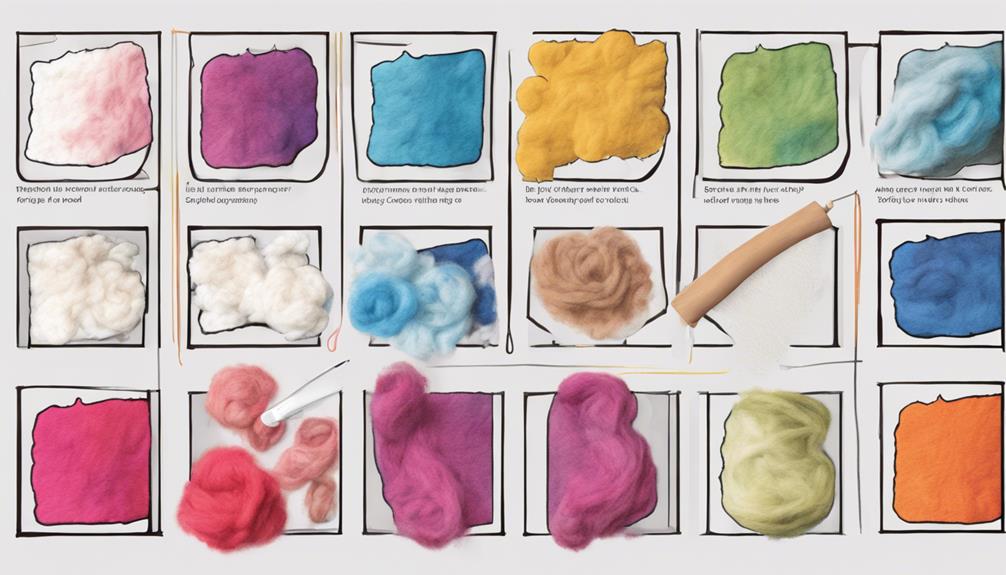
First, let's talk about felting techniques and how they create dense fabric by matting fibers like wool.
Then, we'll explore the various methods of dyeing that can be used to apply color to yarn or fabric.
Felting Techniques Explained
To create intricate textile pieces, mastering felting techniques, including the processes of felting and dyeing, is crucial in achieving vibrant and durable results.
Here are some key points about felting techniques:
- Felting involves matting fibers like wool or fur together to create a dense fabric through friction and moisture.
- Dyeing is the process of applying color to yarn or fabric using various methods like direct, solvent, acid, or heat transfer dyes.
- Felting can be done on a loom or by hand, resulting in durable, textured, and versatile textile pieces.
- Dyeing textiles can be customized on a small or large scale, allowing for creativity in color application for various artistic purposes.
Both felting and dyeing processes play essential roles in textile art, providing artists with a broad spectrum of possibilities to craft unique and vibrant fabric pieces.
Dyeing Process Overview
Exploring the dyeing process in textile art reveals the intricate methods of applying vibrant colors to yarn or fabric through various dye types and techniques. Dyeing involves using liquid, powder, or gas dyes to add color to fibers like wool, offering endless creative possibilities.
On the other hand, felting in textile art entails matting fibers such as wool or fur to create dense fabric through a process involving heat, moisture, and agitation. Both dyeing and felting are fundamental techniques in textile art, allowing artists to experiment with color, texture, and design.
Dyeing can be carried out on a large or small scale, utilizing different dye types such as direct, solvent, acid, or heat transfer dyes. Felting, commonly done on a loom, involves intertwining and compacting fibers to produce solid, durable fabric with unique textures and patterns.
These techniques open up a world of creative expression in textile art, offering artists the opportunity to explore a myriad of artistic possibilities.
Textile Color Application
In textile art, the process of applying color through felting and dyeing techniques offers artists a dynamic avenue for creating vibrant and textured fabric pieces.
- Felting involves matting fibers like wool or fur to create dense fabric with unique textures.
- Dyeing techniques include applying color to yarn or fabric using liquid, powder, or gas dyes for vibrant results.
- Felting can be done on a loom or by hand, providing versatility in creating different fabric textures.
- Various dyeing processes, such as direct, solvent, acid, and heat transfer methods, result in distinct color effects.
These techniques are essential in textile art, enabling artists to craft visually striking and expressive pieces by manipulating fibers and colors through felting and dyeing processes. The combination of these methods allows for the creation of intricate designs and patterns that enhance the overall aesthetic appeal of the fabric artworks.
Educational Resources and Benefits
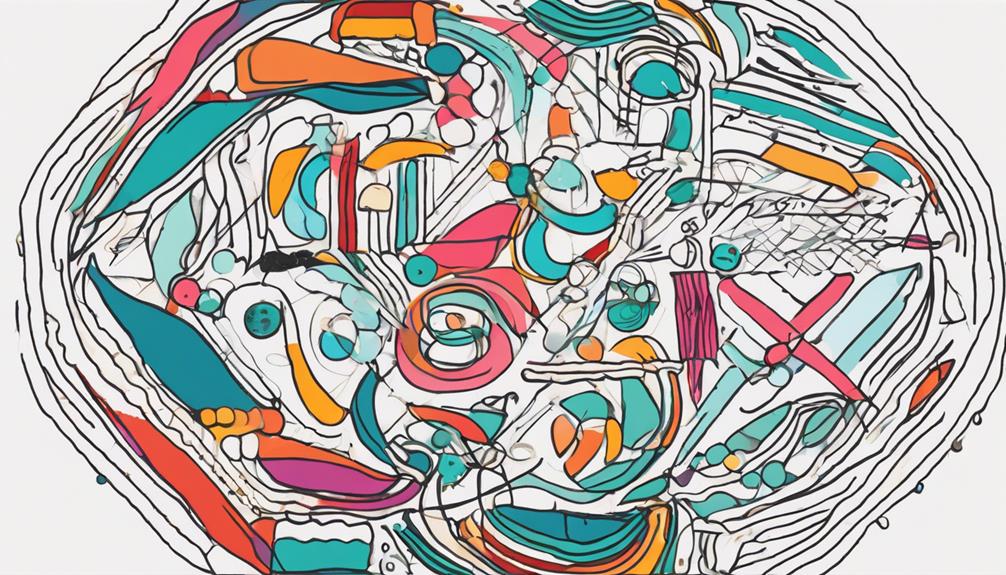
You can explore a wealth of educational resources and benefits through Study.com for your textile art education needs.
With membership access, you gain a variety of tools like quizzes, worksheets, and lesson plans to enhance your teaching experience.
The user-friendly lesson plans provided can assist you in preparing and delivering engaging textile art lessons to your students.
Membership Access Benefits
By becoming a member, you gain access to Study.com's extensive collection of educational resources, including over 30,000 video lessons, quizzes, worksheets, and lesson plans. With this membership, you can benefit from:
- Diverse Learning Materials: Explore a wide range of resources suitable for teaching various subjects.
- Teacher Support: Access tools that aid in lesson preparation and delivery, enhancing your teaching experience.
- Unlimited Study Opportunities: Enjoy unlimited access to study materials that can assist both teachers and students.
- Highly Recommended: Study.com comes highly recommended by educators for its all-inclusive resources and classroom integration tools.
These benefits empower you to enhance your teaching methods, engage students effectively, and foster a dynamic learning environment. Join Study.com today to open a wealth of educational resources tailored to support your teaching journey.
Educational Resource Variety
Study.com's extensive assortment of educational resources for textile art education includes over 30,000 video lessons and various teaching materials. Membership grants access to quizzes, worksheets, and detailed lesson plans, making it a valuable tool for educators.
With registration, teachers benefit from unlimited access to a wide range of educational content, simplifying lesson preparation and enhancing teaching effectiveness. The platform's user-friendly interface has garnered high praise from educators, who appreciate its thorough resources and ease of use.
Study.com also offers classroom integration tools that enable seamless incorporation of educational materials into teaching practices, fostering engaging and interactive learning experiences for students. By utilizing Study.com's diverse teaching resources, educators can enhance their textile art education curriculum and provide students with a rich and immersive learning environment.
User-Friendly Lesson Plans
With a wide range of educational resources at your disposal, accessing Study.com's user-friendly lesson plans for textile art education is a breeze. Whether you're a teacher looking to enhance your curriculum or a student keen to explore further into the world of textile art, Study.com offers a range of engaging content designed to facilitate learning.
Here are some benefits you can enjoy:
- Membership grants you access to quizzes, worksheets, and detailed lesson plans tailored for textile art education.
- Registration provides unlimited opportunities to explore educational content, ensuring a thorough understanding of the subject.
- Study.com comes highly recommended by educators for its classroom integration tools, making it a valuable resource for teaching textile art.
- Users can benefit from engaging instructor-led content that sparks high viewer engagement, creating an interactive learning experience that fosters knowledge retention.
Make the most of these resources to elevate your textile art education journey!
Historical Evolution of Textile Art

Throughout history, the evolution of textile art has been marked by a shift from practical to decorative purposes, showcasing the adaptability and creativity of artists working with fabric.
Textile art has a rich history dating back to 500 BCE, where ancient techniques like dyeing, weaving, embroidery, knitting, and crochet were employed. These historical craft skills continue to influence contemporary textile art practices, reflecting cultural practices and the significance of textiles in society.
Over time, technological advancements such as the invention of the loom and mechanization in the 18th century revolutionized textile production methods, paving the way for artistic movements and the development of contemporary textile art practices.
Examples of ancient textile art provide insights into the history of textiles, cultural influences, and how the medium has evolved to reflect historical events, showcasing its enduring relevance and the diversity it brings to the artistic world.
Frequently Asked Questions
What Is the Meaning of Textile Art?
When considering the meaning of textile art, recognizing its diverse techniques and materials is crucial.
Artists blend fibers and fabrics to create unique pieces that blur the lines between craft and contemporary art.
Through weaving, embroidery, knitting, and felting, these creators convey narratives and emotions, infusing cultural expressions into their work.
Textile art's rich history showcases its evolution from practicality to a form of creative expression that adds depth and meaning to artistic endeavors.
What Is Textile Design in Simple Words?
Textile design, in simple terms, is the creative process of crafting patterns and structures for fabrics.
Imagine this: every day, over 2 billion yards of fabric are produced worldwide through textile design.
From selecting colors to designing motifs, textile designers infuse artistry and technical skills into creating clothing, home decor, and accessories.
Their work influences fashion trends, interior design, and various industrial textiles.
It's a fascinating blend of creativity and functionality!
What Are the Characteristics of Textile Art?
When exploring the characteristics of textile art, you'll find a fusion of traditional crafts and modern art forms. Artists use fibers, fabrics, and threads to weave narratives and showcase their creativity.
What Is a Textile Simple?
A textile, simply put, is any material made of fibers or fabrics like cloth, yarn, or thread. It can be natural, like cotton or wool, or synthetic.
Textiles are versatile and used in various applications, from clothing to home decor.
Understanding the basics of textiles can help you appreciate the intricacies of textile art, a creative field that uses these materials to produce stunning works of art through techniques like weaving, embroidery, and knitting.
Conclusion
So there you have it – textile art is simply the art of creating beautiful pieces using fabric and thread.
From weaving to embroidery, there are countless techniques to explore.
So why not dip your toe into the world of textile art and see where the thread takes you?
After all, the world is your oyster when it comes to expressing yourself through fabric and fiber!

